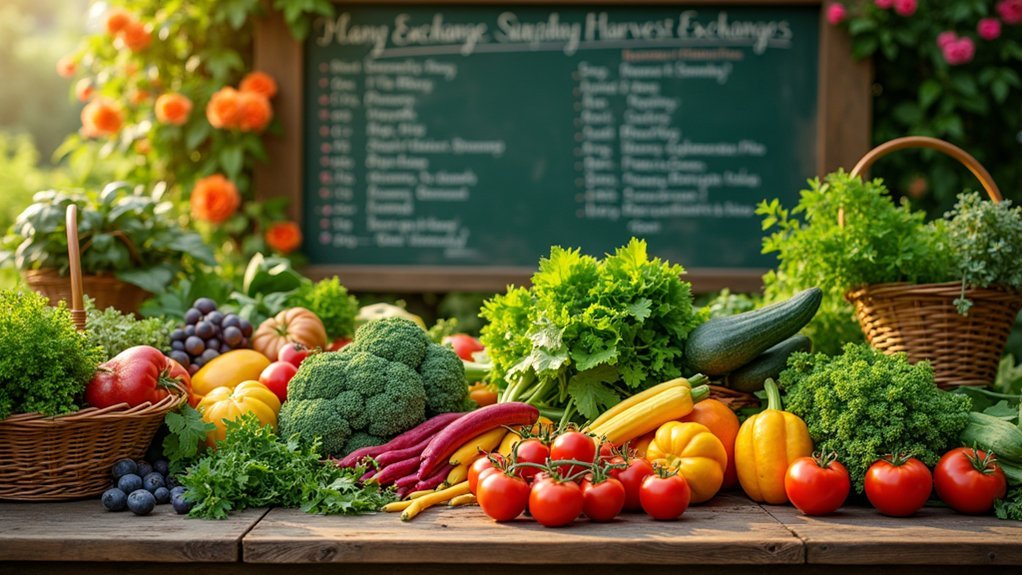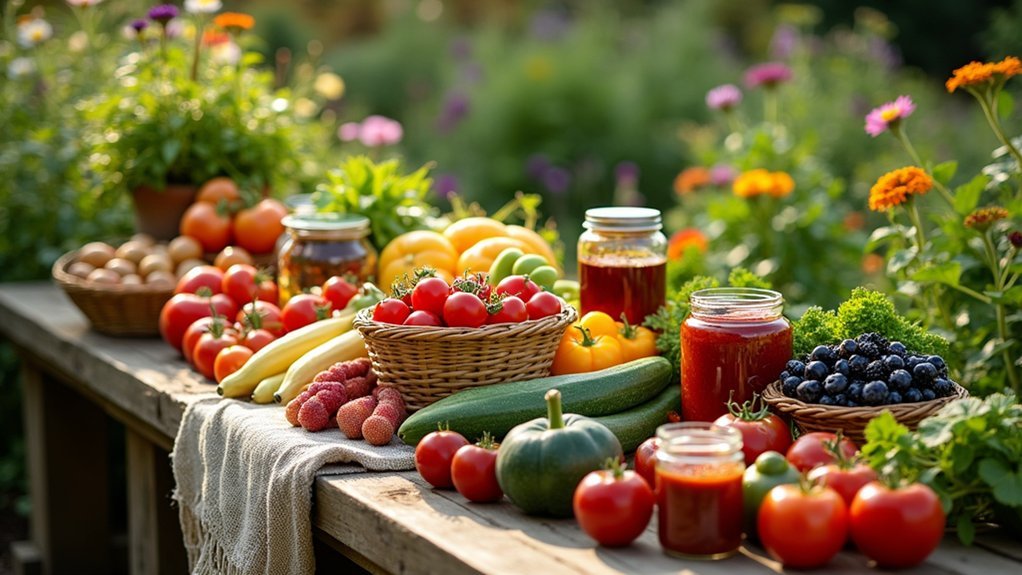You can share your community garden's bounty with neighbors through organized harvest exchanges where everyone brings excess produce to swap. Digital platforms like social media groups or apps such as Fresh Food Connect make coordinating these exchanges simple and accessible. Consider hosting seasonal celebration events like potlucks or small festivals featuring dishes made from your collective harvest. These sharing methods build stronger neighborhood connections while ensuring no homegrown goodness goes to waste.
Organized Harvest Exchanges in Neighborhood Gardens

While individual gardening efforts yield personal satisfaction, organized harvest exchanges transform solitary pursuits into community celebrations.
You'll find these structured sharing systems create meaningful connections as you trade your excess produce with neighbors.
Consider establishing weekly or monthly exchanges where you can bring your garden surplus and return home with diverse local food.
Picture yourself walking home with baskets of neighborhood-grown treasures, each garden's best offerings building community one exchange at a time.
These gatherings reduce waste while enhancing food security right in your neighborhood.
Coordinate your efforts through community boards or social media, letting others know what you'll be bringing.
Try organizing themed exchanges around seasonal abundance—whether it's summer tomatoes or fall squash—to make events more engaging.
Beyond the practical benefits of fresh produce, you're cultivating relationships that strengthen neighborhood bonds and encourage sustainable practices among fellow gardeners.
Digital Platforms for Coordinating Urban Garden Sharing
As urban gardening flourishes, digital platforms have revolutionized how neighbors share their harvests. You'll find community groups on social media where you can post about your excess tomatoes or zucchini, connecting with neighbors who might enjoy your fresh produce while preventing food waste.
Apps like Fresh Food Connect make donating surplus easier than ever, allowing food pantries to coordinate pickups directly from your garden gate.
Meanwhile, dedicated food-sharing websites provide vital information about local food shelves needing donations.
Services such as Each Green Corner link your garden directly with food-insecure community members, creating meaningful connections beyond simple donations.
For more casual exchanges, online forums help organize neighborhood veggie swap meets, ensuring your bumper crop of cucumbers finds appreciative homes rather than your compost bin.
Celebrating Seasonal Abundance Through Community Events

When the harvest season reaches its peak, neighborhood gardens burst with colorful bounty that's perfect for community celebrations. You'll find genuine connection through potluck gatherings where everyone brings dishes made from their garden's yield, showcasing diverse food traditions.
| Event Type | Emotional Benefit | Community Impact |
|---|---|---|
| Harvest Festivals | Joy & Pride | Strengthens neighborhood bonds |
| Seasonal Swaps | Gratitude | Reduces food waste from extra produce |
| School Garden Days | Wonder | Educates children about gardening |
Organize produce exchanges where neighbors trade their extra vegetables, fruits, and herbs. Local schools and churches make ideal venues for these gatherings, creating educational opportunities alongside community building. Collaborative projects like communal gardens or roadside stands transform individual gardening efforts into shared neighborhood experiences that nourish both bodies and relationships.
Frequently Asked Questions
What Vegetables Should Not Be Planted Next to Each Other in a Garden?
You shouldn't plant tomatoes near potatoes, cucumbers beside sage or rosemary, carrots with dill, beans next to onions, or corn near tomatoes. They'll compete for nutrients or share pests and diseases.
How Do You Structure a Community Garden?
Structure your community garden with designated individual plots, shared common areas, clear guidelines for maintenance, and regular meetings. You'll benefit from raised beds for accessibility and a communal composting area for sustainable gardening practices.
How Do I Stop People From Coming Into My Garden?
Install a fence, plant thorny shrubs, or post clear "No Trespassing" signs. You'll also benefit from motion-activated lights and security cameras. Building relationships with neighbors can create respect for your property boundaries.
How to Organize a Garden Layout?
Arrange your garden by evaluating sunlight, water access, and space. Group plants with similar needs together, create wide pathways for accessibility, use vertical gardening for climbing plants, and implement crop rotation to maintain soil health.
In Summary
You've now got three effective ways to share your garden's bounty with neighbors. Whether you're organizing harvest exchanges, using digital platforms to coordinate sharing, or planning seasonal celebrations, you're building community while ensuring no produce goes to waste. By participating in these garden-sharing activities, you're not just exchanging vegetables—you're cultivating relationships that make your neighborhood stronger and more connected through shared abundance.





Leave a Reply